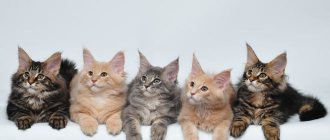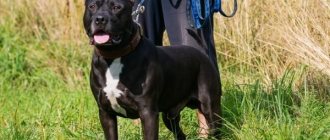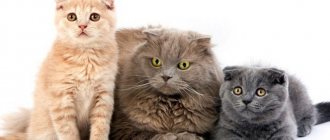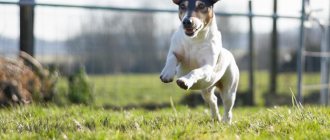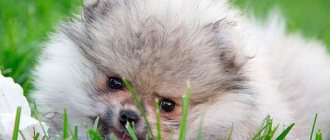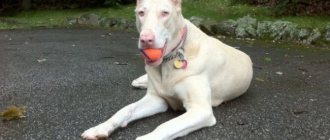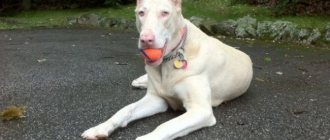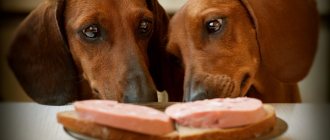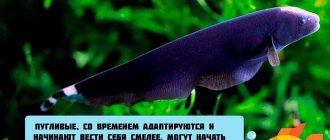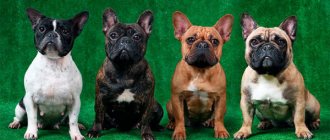The clumsy, funny, clumsy Shar Pei has a heart full of love for the family in which he lives, the makings of a psychologist and nanny, and in dangerous situations he will become a fearless defender.
Cute, unique, numerous folds of skin, varied coat colors and character traits make this dog one of the most popular in the world.
How long do Shar Peis live?
The average lifespan of a purebred Shar Pei is 10 years.
The life expectancy of a Shar Pei living at home is influenced by the following factors:
- Heredity.
- Dimensions. The larger the animal, the more energy the body expends to maintain its vital functions.
- Compliance by owners with the rules of keeping a dog.
- Regularity of sexual activity and number of births for females.
Price range
The price of a dog depends on its quality and ranges from 20 to 45 thousand rubles. For puppies, 3 groups are defined, such as:
Show class. Dogs with great potential, intended for exhibitions and breeding. They have an excellent pedigree and an ideal exterior. These are the most expensive dogs, regardless of whether it is a girl or a boy. Be prepared to shell out from 50,0000 to 65,000 rubles.
Breeding class. Dogs that have slightly lower potential, but with the same excellent pedigree. This class is more involved in breeding. Basically, these are females, the basis of the kennel with remarkable hereditary traits. Breed class puppies are cheaper than show puppies. At the same time, a male breed is cheaper than a female of this class. You will have to count on an amount of at least 25,000 - 35,000 rubles.
Pet class is a pet that will be your best friend, but not suitable for breeding. Accordingly, the price for them will be lower, from 12,000 rubles and above.
Pricing also depends on the region. Shar Pei colors vary in price accordingly. The rare “Isabella dilute” color, as well as “lilac”, are an order of magnitude higher.
Coat types
Shar Peis have fur that resembles velor, so they are somewhat similar to a plush toy.
Depending on the size of the hairs, dogs of this breed are classified according to their hair type as follows:
Horse hairs up to 1 cm in size. The peculiarity of this type: with increasing age and growth of the puppy, the number of folds decreases.
Brush - hairs up to 2.5 cm long. Decreasing along the length of the body, the folds remain on the muzzle and in the neck area.
Bear hair - hair length more than 3 cm. These individuals do not take part in official exhibitions, due to the fact that bear hair is one of the factors that rejects a dog from a purebred.
History of the origin of the breed
Historians who conducted DNA research found that the Shar Pei breed appeared about 3 thousand years ago. This fact was confirmed by excavations, during which sculptures of dogs that looked like Shar-Peis were discovered. They are believed to have originally existed in southern China. Ordinary Chinese peasants got Shar-Peis to guard their houses. Later, dog fighting became a fashion in many provinces. Shar Pei owners began to instill aggression in their pets towards other animals and put trained dogs into fights. This led to colossal losses of representatives of the breed.
The development of communism in China also caused serious damage to the population. It was believed that pets were useless. People began to massively destroy their pets. By 1950, several litters of Shar Peis were preserved.
After 15 years, breeder Chen decided to revive the breed by breeding a Shar Pei named Lucky. The dog was purchased by an American breeder. In 1971, a group of specialists was formed who decided to breed Shar Peis. This is how new individuals were bred, as a result of which it was possible to restore the population. In Russia, the first representatives appeared in the early 90s of the last century.
According to one version, the distant ancestors of the breed were smooth-haired Chow Chows. This is indicated by the color of the tongue. Currently, there are only two of these breeds that have a blue tint to this organ. Some external similarities, genetic matches and appearance at the same time indicate the relationship of the breeds.
There are breeders who believe that Shar-Peis are descended from mastiffs. Because this particular breed is one of the four ancestors of all dogs. Shar-Peis have the greatest similarity with them.
Shar Pei color
In 2005, the Russian Canine Federation approved a register of Shar Pei colors that meet the standards.
The color of the Shar Pei, according to the adopted document, must have the following distinctive features:
- wool is one color. Spots are allowed in white Shar-Peis;
- hind legs are half a tone lighter than the main color;
- the dog's muzzle is slightly darkened;
- A dark stripe in the form of a ribbon is allowed on the back.
It is impossible to describe the entire amazing palette of colors that Shar Peis have. But it is conditionally divided into three parts:
- Main color
- Diluted color
- Unusual color (otherwise called marriage)
The dominant color in the first group is black. Moreover, natural blackness in animals is quite a rare phenomenon. As the puppy grows up, it changes color and instead of black, its coat acquires a brown, brown or olive tint.
The first group includes dogs with the following color scheme:
Cream. Dogs of this color have weak pigmentation; the back, eyes, ears and tail are darker than the main color.
Deer. The oldest color of an animal. A distinctive feature of the wool is a golden shine that shimmers in bright light. As the individual grows older, the color changes to darker.
Red deer. A variety of deer color. Unlike golden fawn, red fawn puppies have dark red or faint light red undertones in their fur.
Isabella. A puppy of this color will win the heart of the owner forever, being the offspring of red and blue specimens, he has a pinkish-cream coat without red pigment with a sky-blue tone.
Red. The most popular tone among breeders. Its varieties are red, red and mahogany tones.
The Blue Shar Pei has an aristocratic appearance. Blue color is a combined concept that includes animal smoky, gray and slate shades.
Sable. At first glance, an animal of this color seems to be sprinkled with grayish pollen, and the spraying was more intense in the areas of the back, tail and muzzle. Taking a closer look, you can see that each hair consists of three parts - light at the bottom, then red, and dark at the tip. The sable color differs from other colors in the presence of zones.
In dilute-colored animals, the black color is completely absent. The group's palette is represented by the following colors:
Cream (creamy shade). Unlike its counterpart from the first group, the cream dilut does not have a dark color on the back and ears, and there is no mask on the face. Their tongue color is lavender and their nose is pink.
Apricot. The color of the fur is golden-red. The play of color from the dark back to the light belly is touching. The pet can be one color. The nose is usually chocolate color.
Red. Dogs of this color have a mask on their muzzle, nose and pads that have a delicate chocolate tint. Regardless of the age of the dog, the color of the dog’s body is uniform.
Chocolate. You can match the animal to the color of your favorite delicacy, due to the fact that the color tone varies from milky to dark. The chocolate dog's tongue is light lilac. If an individual has a blue tongue and a dark color, it is not a chocolate dilute, but a representative of the first group.
Lilac. The dogs are a rare color and have a bluish coating on their faces. Coat color can be chocolate pink, silver pink or dark purple.
Isabella. The rarest color of the Shar Pei, according to the standard a mask is allowed on the face. A characteristic feature of dogs of this shade is the absence of darkening on the back.
Pets of unusual color are called floral, due to the spots they have on their body. Such species are becoming more and more attractive, but are not recognized by all cynological federations. The application submitted to the RKF for inclusion in the register of spotted sharpei colors has not yet received confirmation.
Muzzle
The standard says that in the Shar Pei it is thick and large, reminiscent of the mouth of a hippopotamus. And this is the most accurate description of the “face” of any of the representatives of this breed.
The Shar Pei's muzzle should be massive and wide, not tapering towards the nose. These dogs have heavy and drooping lips, with the upper one being especially large, thick and voluminous.
Dog character
Behind the sullen and gloomy appearance of the Shar Pei lies friendliness, love, kindness, cheerfulness, and curiosity. In addition, the dog has the qualities of a real psychologist.
The character of the Shar Pei has a desire to be a leader, so the owner of such a dog must have a strong and strong-willed character. It is worth noting that already a four-month-old puppy is well versed in the hierarchical structure of the family where he lives.
He will not obey the children, but at the same time he will not offend them. However, the dog should be taught to communicate with children. Dogs ignore individual family members for the rest of their lives.
The animal's aggressiveness increases significantly if you grab it by the legs or suddenly put your hand on it. This is due to the characteristics of peripheral vision, since due to large eyelids it is very weak.
Animals are highly intelligent. If they find themselves in an extraordinary situation, they will not lose their composure. Being alone in a living space while waiting for a long time for the owner will not damage things and clothes. Shar-Peis living outside the city will not run through flower beds and beds, but will walk along well-trodden paths.
The dog completely adapts its regime to the owner’s daily routine:
- the owner lies down to rest or sits down to work, at this time the Shar Pei will take a nap or lie down on its bedding;
- if the pet sees a leash in the owner’s hands, he rejoices and hurries to go for a walk;
- the dog's morning rise time coincides with the owner's routine;
- if suddenly the owner is overcome by sadness, the dog will grieve with him.
The Chinese Shar Pei tolerates trips and travel well. Although traveling with a dog is a troublesome task, neglecting your pet and not wanting to take it with you will negatively affect its character.
Choosing a puppy
One of the most exciting events is choosing a puppy. Set aside enough time to visit exhibitions and take a closer look at the best representatives of the black breed. But it is best to choose a puppy from a kennel from a trusted breeder. The breeder will present all the necessary documents, give guarantees, and most importantly, show the parents. By their appearance and character, you can judge how the puppy will grow up. It is important that the breeder is not indifferent to the fate of the puppies.
As a rule, puppies are ready to live independently at the age of 3 months. Carefully examine the eyes, ears, and fur. A healthy puppy is active, well-fed, with shiny fur.
Consult on how to start feeding correctly and how to care for it. How to win a baby's heart faster. Choosing a nickname is also not an easy task; let the nursery tell you how to choose one that suits your pedigree.
What should a Shar Pei menu be like?
As with feeding any pets, there is a choice of using dry food for feeding or preparing the food yourself.
Both methods have their advantages and disadvantages. Ready-made food should be premium, with a price tag that weighs enough for the owner’s wallet.
Cooking your own food takes personal time and requires purchasing high quality products.
Therefore, an assessment of financial capabilities is prevalent when deciding to adopt a Shar Pei dog into the family.
The dog does not have a good appetite. Long walks and games in the fresh air will help improve your appetite. The dog needs to be fed twice a day.
The diet must include:
- meat and offal. The main part of the diet, any raw meat is suitable, except pork, chicken and raw liver. The last two products can cause severe allergic reactions;
- fish. Served two to three times a week boiled or stewed. The fish should not be fatty and marine. It is important to remove all the bones from a fish dish before serving.
- milk and dairy products. Only puppies can lap up milk. For an adult dog, kefir, yogurt, and low-fat varieties of cottage cheese are suitable.
- quail eggs. They are given several times a week, two pieces raw, along with the shells.
- cereals The diet will be supplemented with boiled buckwheat, rice, and oatmeal; if the dog is obese, the best option for feeding him would be pearl barley.
An excellent addition to the diet will be vegetables: carrots, pumpkin, zucchini, broccoli.
Health and illness
During active growth (up to 9 months), the Shar Pei is vulnerable. It is during this period that he can get sick. An adult dog's immune system is better developed. Common dog diseases include the following.
- Allergies. The main symptoms of allergic reactions are:
- loss of appetite;
excessive hair loss;
- vomit;
- swelling of the muzzle;
- temperature.
- Eye diseases. The eyeballs are the Shar Pei's weakest organ. If the disease is neglected, the dog may lose vision. With inflammation or injury to the eye, swelling and copious mucus secretion are observed. Entropion of the eyelid is also a common disease in the Shar Pei variety. Overhanging folds rub the cornea of the eye. Representatives of the breed have a genetic predisposition to this disease. The problem is solved with surgery.
- Ear diseases. Appear due to improper care. If there is an infection, the dog begins to hear worse, often scratches its ears and shakes its head. Diseases are also manifested by abundant release of sulfur. The doctor prescribes drops and special ear care during rehabilitation.
Allergies occur when the diet is improperly selected. Therefore, it is necessary to coordinate the dog’s diet with your veterinarian.
Shar Pei photos
Matching black hair color to your skin color
You can dye absolutely any hair black, no matter what it is: long or short, curly, straight or bleached, but black is not suitable for everyone.
When deciding to change your hair color, the easiest way is to rely on the theory of color types and skin tone:
Snow-white skin
Remember Snow White from the fairy tale? Light skin is the most ideal option for black hair, this will make your skin look even more porcelain.
Dark skin
Dark shades are perfect for those with dark skin, and the color of a raven wing can highlight your face as much as possible, making it more expressive. The following shades will also suit you: black caramel, plum-black (eggplant-black), dark chocolate, black coffee, mocha.
But when choosing your black color, it is important to focus on your skin undertone:
Yellow undertone skin
If you have a warm skin tone and a “spring” color type, then deep cool black is unlikely to suit you. For a radical change of image, try dark but warm shades with golden notes, such as coffee and chocolate.
Blue/red skin tone
Cool skin tones are ideal for the darkest and richest shades of black. Feel free to choose graphite and ash black, the color of a raven wing. It will look great with a slight blush. For those with porcelain skin with cool undertones, stylists advise avoiding warm shades of black.
Crusts on a cat's nose - what could it be?
Crusts in your pet's nose can be dried boogers or dirt that has gotten into it and become compacted. Pathological factors that can provoke the appearance of crusts in the nasal passages:
- Fungal diseases (actinomycosis, cryptococcosis, candidiasis). Associated symptoms: sneezing, coughing, rashes on the abdomen, itching, fever, general malaise.
- Calicivirus infection, accompanied by the formation of ulcers and erosion on the mucous membranes, inflammation of the conjunctiva, loss of appetite, lethargy, and fever.
- Bordetellosis, the main symptoms of which are crusts on the nose, cracks, sores, purulent discharge, fever, inflammation of the lymph nodes, shortness of breath, coughing, sneezing.
- Allergy.
- Mechanical damage.
Cost of representatives of the suit
Buying a horse of this color is very difficult, there are not very many of them in the world and they cost a fortune; most people simply cannot afford animals. Previously, only emirs or sultans could afford an Isabella horse. After all, a lot of gold was given for a good horse of a given color; it had to be as much as the animal itself weighed. At this stage of time, the price of an Isabella horse can be more than three million dollars.
However, its cost is completely justified. It is enough to see her just once and then you will never confuse or forget the horse of Isabella color. She bears with great honor the “royal name”, which completely characterizes her. This horse immediately speaks of the status of its owner and is an image of wealth, luxury and high cost of its rider. One can only be proud and admire her.
Isabella color is a divine and magical color. Many people want to take possession of it. There is a legend that this color has many similarities with a pure white lamb of good color. Such a horse brings good luck to its owner.
Features of genetics
If we consider the origin of the Isabella color from the genetic point of view, it should be noted that this breed has several types of progenitors.
For example, let’s take America, where they use the term “cremello”. It means all types of breeds that have red representatives in their genetic origin. In the family of the Isabella breed there are already two red descendants. Based on this, the color is considered the rarest breed in the whole world and quite expensive. After all, if you want a real royal purebred Isabella horse to be born, then you need to cross two completely identical genes, and this is quite difficult.
Such genetic values are found only in palomino, dun and elephant horses. The ordinary black pigment of the standard gene always drowns out the powerful cream gene and the latter lightens the black pigment. Only the Akhal-Teke breed of animals has light colors. That is why it is quite common to see an Akhal-Teke horse of Isabella color.
As already mentioned, this color can be in dun or salt breeds, and this is understandable. But certain Isabella breeds cannot be registered. Not very long ago, the AQHA (American Quarter Horse Association) organization launched a stud book specifically designed for horses of this color. Recently, this association has begun registering all animals that are born as a result of the union of two palomino horse breeds.
In the United States of America there is a special association dedicated to owners of the Isabella breed. It's called the American Albino and Creme Horse Registry. Albino does not mean that this association is also intended for albino horses, if only because there are no true natural albinos in nature. In this association, not only Isabella horses can be registered, but also white horses that have one of the most important alleles of the White gene in their genotype.
Phasing in Bengal kittens
The spectacular color characteristic of Bengals does not appear immediately after birth. The pattern on a kitten's fur is unknown even at the time of moving to a new home. The babies are covered with thin hairs of a white, gray or red hue with a non-distinctive pattern. Up to a year, a Bengal cat can resemble a simple yard striper.
The phasing effect confuses buyers, because at the time of purchase the main qualities of the breed are hidden and you can only trust the reputation of the breeder.
The kitten's bright appearance is hidden due to phasing, which serves as a natural camouflage. The baby's coat begins to change at the age of 12-15 weeks, and ends no earlier than 7 months. The lighter the background of the coat, the sooner the camouflage disappears, while dark merle colors appear slowly. However, watching your pet grow brings pleasure, as the Bengal is transforming every day. By the age of 2, the beauty of a purebred Bengal cat is fully revealed.
Among the colors of the Bengal you can find both bright patterns and restrained tones. The diversity of the wild palette, combined with some unpredictability, makes the Bengal cat breed attractive to lovers of natural beauty.
Best Allergist: How to distinguish food intolerance from food allergies
I like3I don't like
Pros of dyeing your hair black
- Usually hair is dyed to cover gray hair. Dark shades of paint are ideal for combating gray hair. The black pigments of modern coloring products penetrate deep into the hair for a long time, last a long time and practically do not wash off.
- Glossy shine looks especially effective and advantageous on black strands of hair.
- This color is considered the most spectacular and sexy when creating the style of a fatal beauty. For example, the image of Cleopatra at all times attracts men with its sexuality, inaccessibility and majesty.
- There is a popular saying that men love blondes and marry brunettes. This happens because brunettes give the impression of a confident partner. Men see them as a reliable support for a future family, and blondes are usually associated with a frivolous and stupid mentality.
- Psychologists say that brunettes achieve career growth and wealth much more successfully than fair-haired women, since dark colors, especially brown tones, have a beneficial effect on the business environment; business people or politicians tend to trust and listen to strict, prudent, characterful, strong colleagues and partners.
- Stylists and fashion designers claim that black hair goes well with clothes of all colors and shades, especially white and red. It’s easy for brunettes to experiment with clothes in different colors; almost everything suits them.
- This color has always been considered a classic; it has been in trend among couturiers and fashionistas on ordinary city streets for several seasons now and will most likely never go out of fashion.
Best South African Boerboel
Think carefully before purchasing
The Shar Pei breed is distinguished by its desire for leadership and has a very complex character. Don't buy a dog if:
- You are not self-confident and do not have leadership qualities;
- The family has small children;
- There are already any other animals;
- There is no time to spend daily training with the dog, showing a dominant position in the family;
- Are you afraid of dogs?
- This is your first dog, and there is no experience with intelligent animals prone to leadership positions.
From the first minutes of living in a new family, Shar Pei will begin to show who is boss. If you are soft, he will feel like a leader, and nothing good will come of it. The same applies to all family members; it is impossible for one (for example, a spouse) to be strict with the dog, and the second (for example, his wife) to baby the dog.
On the contrary, when he understands that you are a leader, the Shar Pei will have the meaning of life to protect you from dangers, and give you all the love and devotion that he is capable of. In general, this is a breed with a character, and far from the softest, and you will need an army streak. Although it is worth saying that breeders are working hard on its character, and there is progress in this direction, today you can buy a fairly calm, wise dog that wouldn’t hurt a fly.
Breed characteristics
- Height – up to 51 cm;
- Weight – up to 25 kg;
- Life expectancy – up to 12 years;
- Skin – deep folds;
- The coat is short;
- Color – black, cream, blue, apricot, chocolate, lilac;
- The color of the tongue is blue, lavender, pink pigmentation is possible.
Different coat colors
A good trait of the breed is that it does not have a particular tendency to bark for no reason. A Shar Pei will never allow a stranger into the yard; he will bark menacingly until the owner leaves the house, but if a stranger simply passes by, the dog simply follows him with his gaze. Shar Pei has a high intelligence, he simply understands that there is no point in shaking the air.
The second good trait is unobtrusiveness. The dog will calmly and politely greet you from work, will not jump on his chest and demand you throw the stick in the heat of play. But he will never miss a walk next to his owner; he becomes very attached to his loved one.
Red deer
- a variant of the deer color, distinguished by a dark fawn or dark red tint. There is one peculiarity of dogs of this color. With age it becomes more intense.
Strengths
The appearance of a representative of this suit is quite deceptive. From the outside the horse is very:
- tender;
- fragile;
- defenseless.
But in fact, this breed is characterized by incredible strength and its defenselessness hides quite strong endurance. The animal is not affected in any way by climatic conditions. It feels great in extreme heat up to +50 degrees and in incredible cold down to -30.
The Isabella horse with its strong nature has acquired many different legends. For example, during the war, this animal could carry away three severely wounded people through quicksand.
The horse makes fairly smooth movements and at the same time has good flexibility. Also, its skin is surprisingly thin, and its hair is smooth and silky with short hairs, but the horse’s mane is not very thick. The Isabella specimen has a long, high-set neck with a graceful curve. She always has a powerful, proud and majestic posture.
